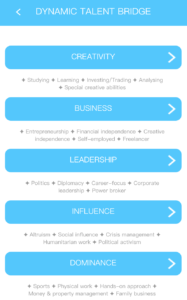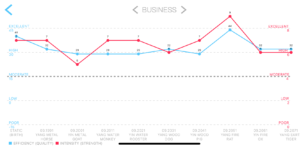 The Dynamic Talent Bridge is an enhancement of our existing Talent Bridge feature.
The Dynamic Talent Bridge is an enhancement of our existing Talent Bridge feature.
As you may already know, the Talent Bridge illustrates the interaction between various Character Components, measuring their intensity and efficiency. These different Talent Bridges offer profound insights into specific talents and abilities.
For example, suppose someone has a strong Intellect Component (Resource) alongside a robust Wealth Component. In that case, it suggests they are well-suited for business or have a natural inclination toward financial independence, potentially leading them to work for themselves.
In its original form, the Talent Bridge is static, as it only considers the strength of the Character Components at the time of birth.
However, a BaZi chart consists of both a Static Chart and Dynamic Luck (Luck Pillars). Each Luck Pillar influences the Static Chart, which means that the strength and balance between Character Components change every ten years due to various activations.
The Dynamic Talent Bridge takes this into account, incorporating information from the Dynamic Luck chart and displaying a dynamic view of these interactions for each 10 years. This allows us to observe how the intensity and efficiency of specific Talent Bridges fluctuate over time.
For example, Mark Zuckerberg‘s chart below illustrates the progression of his Business/Entrepreneur Talent Bridge across different periods. The indicators show that he naturally possesses a fully functional Business Talent Bridge throughout his life, consistently hovering between the High and Excellent levels.

Efficiency and Intensity Indicators
In general, for a Talent Bridge to be effective, both efficiency and intensity indicators (represented by the blue and red lines) should be above the moderate level and close together. When both lines are above a moderate level and relatively close together, it means that this particular Talent Bridge is strong and efficient, and the person can utilize it.
If a certain Talent Bridge is missing or very weak in the Static chart (first data point), we then look into Luck Pillars to see if that Bridge is established in some other period.
When this happens, it’s an ideal time to focus more energy and attention on the activities associated with that particular Talent Bridge. Taking advantage of these periods can lead to greater success in the areas where the Talent Bridge is active.
Here is a detailed breakdown of the indicators, based on the positions of Efficiency and Intensity:
- Both indicators at the Poor line: This indicates that one or both Components required for the Talent Bridge are missing, meaning the Talent Bridge is not established.
- Both indicators around the Low line: While the Talent Bridge is formed, it is relatively weak, making its utilization questionable.
- Both indicators around the Moderate line: The Talent Bridge is well established and can be used, but with certain limitations.
- Both indicators around the High line: The Talent Bridge is powerful and easy to use.
- Both indicators around the Excellent line: This represents the most dominant Talent Bridge, serving as the main driving force in the chart.
- Indicators are too far apart: If the indicators are significantly separated, it suggests that one Component is much stronger than the other. While this situation is not ideal, the Bridge can still function, depending on other specifics within the chart.
Please note that this module only examines the strength and ratio of Components; other factors, such as clashes between branches, can negatively influence a particular Talent Bridge. We recommend contacting our experts for a more specific analysis.
